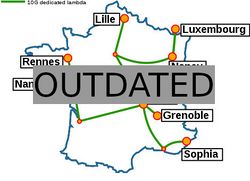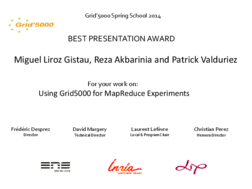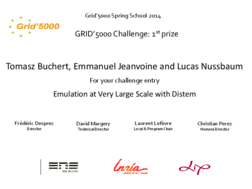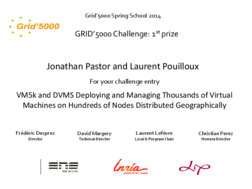Grid5000:Home: Difference between revisions
No edit summary |
No edit summary |
||
| Line 9: | Line 9: | ||
Key features: | Key features: | ||
* provides '''access to a large amount of resources''': 1000 nodes, 8000 cores, grouped in homogeneous clusters, and featuring various technologies: 10G Ethernet, Infiniband, GPUs, Xeon PHI | * provides '''access to a large amount of resources''': 1000 nodes, 8000 cores, grouped in homogeneous clusters, and featuring various technologies: 10G Ethernet, Infiniband, GPUs, Xeon PHI | ||
* '''highly reconfigurable and controllable''': researchers can experiment with a fully customized software stack thanks to bare-metal deployment features, and can isolate their experiment at the networking | * '''highly reconfigurable and controllable''': researchers can experiment with a fully customized software stack thanks to bare-metal deployment features, and can isolate their experiment at the networking layer | ||
* '''advanced monitoring and measurement features for networking and power consumption''', to provide a deep understanding of experiments | * '''advanced monitoring and measurement features for networking and power consumption''', to provide a deep understanding of experiments | ||
* '''designed to support Open Science and reproducible research''', with full traceability of infrastructure and software changes on the testbed | * '''designed to support Open Science and reproducible research''', with full traceability of infrastructure and software changes on the testbed | ||
Revision as of 23:46, 22 January 2015
|
Grid'5000 is a large-scale and versatile testbed for experiment-driven research in all areas of computer science, with a focus on parallel and distributed computing including Cloud, HPC and Big Data. Key features:
|
Latest publications from Grid'5000 users
Five random publications that benefited from Grid'5000 (at least 2780 overall):
- Chih-Kai Huang. Scalability of public geo-distributed fog computing federations. Other cs.OH. Université de Rennes, 2024. English. NNT : 2024URENS055. tel-04910860v2 view on HAL pdf
- Sorina Camarasu-Pop. Computational Reproducibility. 3rd cycle. 12th SLEIGHT Science Event, Saint Etienne (FR), France. 2024. hal-04649287 view on HAL pdf
- Abdoulaye Diop, Nahid Emad, Thierry Winter. A Parallel and Scalable Framework for Insider Threat Detection. 2023. hal-04197467 view on HAL pdf
- Igor Fontana de Nardin. Ordonnancement en ligne de tâches IT et engagement de sources dans un centre de calcul alimenté par des énergies renouvelables. Réseaux et télécommunications cs.NI. Institut National Polytechnique de Toulouse - INPT, 2023. Français. NNT : 2023INPT0104. tel-04361471 view on HAL pdf
- Alan Lira Nunes, Cristina Boeres, Lúcia Maria de A. Drummond, Laércio Lima Pilla. Optimal Time and Energy-Aware Client Selection Algorithms for Federated Learning on Heterogeneous Resources. 2024 IEEE 36th International Symposium on Computer Architecture and High Performance Computing (SBAC-PAD), Nov 2024, Hilo, France. pp.148-158, 10.1109/SBAC-PAD63648.2024.00021. hal-04690494v2 view on HAL pdf
Latest news
Grid'5000 tutorial days in Lille
We are happy to let you known that tutorials around Grid'5000 will be organized in Lille on November 20th, 2014, with a few seats available for people outside Lille. All information on the dedicated web page.
Grid'5000 spring school now finished
The Grid'5000 spring school took place between June 16th, 2014 and June 19th, 2014 in Lyon. Three awards were given for presentation or challenge entries (the challenge entries ended as a tie):
|
Best presentation award to Miguel Liroz Gistau, Reza Akbarinia and Patrick Valduriez |
Best challenge entry to Tomasz Buchert, Emmanuel Jeanvoine and Lucas Nussbaum |
Best challenge entry to Jonathan Pastor and Laurent Pouilloux |
Grid'5000 sites
Current funding
As from June 2008, INRIA is the main contributor to Grid'5000 funding.
INRIA |
CNRS |
UniversitiesUniversity Joseph Fourier, Grenoble |
Regional councilsAquitaine |





